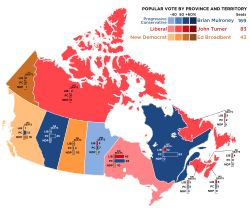1988 Canadian election
|
|
|||||||||||||||||||||||||||||||||||||||||||||||||
|---|---|---|---|---|---|---|---|---|---|---|---|---|---|---|---|---|---|---|---|---|---|---|---|---|---|---|---|---|---|---|---|---|---|---|---|---|---|---|---|---|---|---|---|---|---|---|---|---|---|
|
|||||||||||||||||||||||||||||||||||||||||||||||||
|
|
|||||||||||||||||||||||||||||||||||||||||||||||||
|
295 seats in the 34th Canadian Parliament 148 seats needed for a majority |
|||||||||||||||||||||||||||||||||||||||||||||||||
| Turnout | 75.3% | ||||||||||||||||||||||||||||||||||||||||||||||||
|
|||||||||||||||||||||||||||||||||||||||||||||||||

|
|||||||||||||||||||||||||||||||||||||||||||||||||
|
|||||||||||||||||||||||||||||||||||||||||||||||||
Brian Mulroney
Progressive Conservative
Brian Mulroney
Progressive Conservative
The Canadian federal election of 1988 was held November 21, 1988, to elect members of the Canadian House of Commons of the 34th Parliament of Canada. It was an election largely fought on a single issue: the Canada-U.S. Free Trade Agreement (FTA).
Incumbent Prime Minister Brian Mulroney, leader of the Progressive Conservative Party, had signed the agreement. The Liberal Party, led by John Turner, was opposed to the agreement, as was the New Democratic Party led by Ed Broadbent.
The Conservatives went into the election suffering from a number of scandals. Despite winning a large majority only four years before, they looked vulnerable at the outset.
The Liberals had some early struggles, notably during one day in Montreal where three different costs were given for the proposed Liberal daycare program. The campaign was also hampered by a Canadian Broadcasting Corporation report that stated there was a movement in the backroom to replace Turner with Jean Chrétien, even though Turner had passed a leadership review in 1986.
Support swung back and forth between the Conservatives and Liberals over free trade. With mid-campaign polls suggesting a Liberal government, this prompted the Conservatives to stop the relatively calm campaign they had been running, and go with Allan Gregg's suggestion of "bombing the bridge" that joined anti-FTA voters and the Liberals: Turner's credibility. The ads focused on Turner's leadership struggles, and combined with over $6 million CAD in pro-FTA ads, managed to stop the Liberals' momentum.
...
Wikipedia



